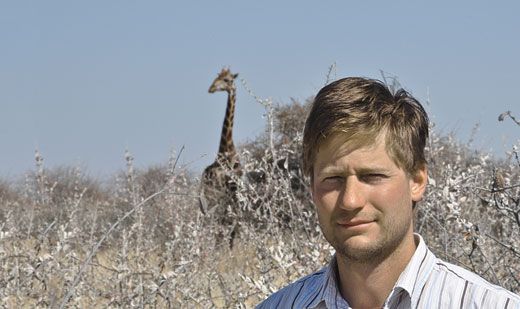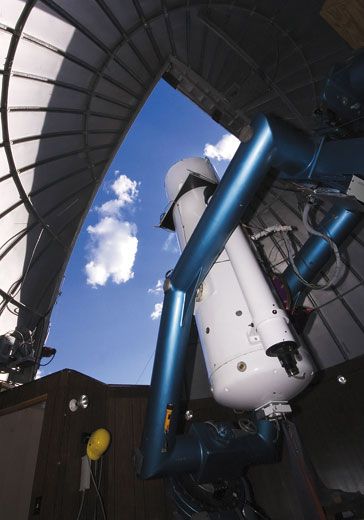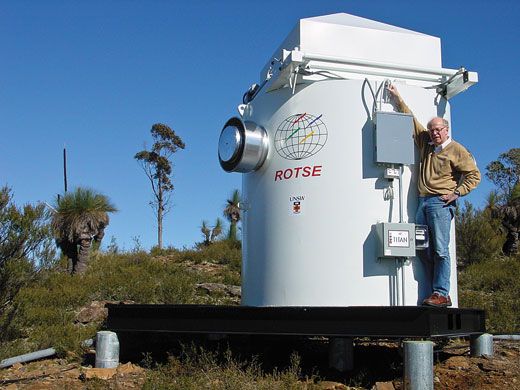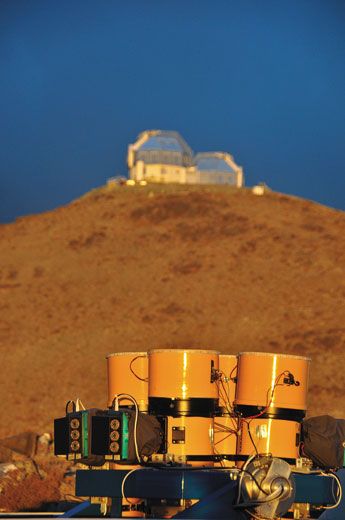Pint-Size Sky Watchers
While monster telescopes get the attention, the little guys quietly — and cheaply — rack up cosmic finds.
/https://tf-cmsv2-smithsonianmag-media.s3.amazonaws.com/filer/small-telescopes-Atacama-desert-sky-3-flash-631.jpg)
If Gáspár Bakos ever needs to condense his job description into an elevator pitch, it might go something like this: Travel the world, dodge snakes, discover new planets.
The Hungarian-born Princeton astronomer is doing a bit of repair work on an overcast spring afternoon in Arizona’s Santa Rita Mountains, poking into an electronics box that controls one of five small telescopes he oversees at the Smithsonian’s Fred Lawrence Whipple Observatory near Amado, 35 miles south of Tucson. The cluster of telescopes forms most of HATNet, the Hungarian-made Automated Telescope Network, which hunts for planets in other star systems. Two more telescopes are in Hawaii, and a second network, HATSouth, spreads from Namibia to Chile to Australia. Together, these little telescopes are able to search wide swaths of the sky to make voluminous catalogs of cosmic objects.
Bakos is in Arizona because the top of one of the box-shaped telescope enclosures refuses to open. To keep the remotely operated telescopes running, he sometimes travels 100,000 miles a year. His journeys bring him close to the many varied objects of the universe, not to mention a menagerie of creatures on this planet as well.
“One time this telescope had a black widow inside,” Bakos recalls, jabbing his finger at the spot in the Whipple telescope where he found the nasty visitor. “Namibia has snakes. They’ve never gotten into the telescopes, but they’re all over the place. This site [in Arizona] has the sun spider, which is as bad as a scorpion. It has a gigantic mouth, which is really scary, with a lot of teeth in it.”
For those who operate small telescope networks, there’s no such thing as “not my job.” “It’s like working at a small business, because if something needs to be done, you do it,” says Ed Beshore, who recently left his post as head of the University of Arizona’s Catalina Sky Survey, which hunts for asteroids and comets that come close to Earth’s orbit, to become deputy principal investigator for OSIRIS-REx, a NASA asteroid sample-return mission scheduled to launch in 2016. “I’ve swept the floors at the observatory, I’ve ripped the telescope apart and pulled the mirrors out and pulled the cameras off, I’ve written software, and I’ve written grant proposals.”
Networks of small telescopes are contributing to science in ways most astronomers couldn’t have envisioned just a couple of decades ago. They have increased by 60 times the number of known asteroids in the solar system, discovered several dozen extrasolar planets, cataloged thousands of exploding stars, and helped solve some of the mysteries of the most powerful blasts in the universe. Though they’re called “networks,” the telescopes aren’t wired together; they’re just a collection of instruments that are all assigned the same task. These telescopes are generally 40 inches in diameter or smaller, and by working in groups they are especially suited to record changes in large areas of the sky over periods of days, weeks, or even years. “Historically, we’ve always gone deeper—to the very edges of the universe, or nearby but very faint, and that’s the role of giant telescopes,” says David Charbonneau, a Harvard astronomer and lead scientist for MEarth, another Whipple-based project, which uses a set of eight identical 16-inch telescopes to hunt for planets around small, cool stars known as M dwarfs. “But the time domain has been neglected,” he says. “The idea of studying stars and seeing how they change is fairly new,” enabled over the past couple of decades by the advent of these small, wide-field-of-view telescope networks.
Whipple is home to not only the small telescopes of HATNet and MEarth, but also one of the largest telescopes in the world, the giant MMT. Its primary mirror spans more than 21 feet. “There was this trend in the ’90s that bigger telescopes were always better,” says Bakos, pointing over his shoulder at the MMT. But in the last couple of decades, “the opinion of the [scientific] community changed, and I think they now see small telescopes as essential things in astronomy. I think there’s more funding going into these now, there’s more time given to them, just more understanding of how important they are.” In the field of exoplanets, for example, giant telescopes have done much of the legwork, confirming they exist and pinning down what to look for; now droves of inexpensive, small telescopes can be dedicated to simply finding them all.
Each project at MMT must compete with many other proposals for just a few nights of observing time. HATNet, on the other hand, is made up of four telescopes that are just four inches in diameter, plus a fifth, TopHAT, that is a relatively beefy 10 inches across and performs follow-up work on ambiguous HATNet images. In fact, the whole cluster of telescopes, each one enclosed in what looks like a white barbecue grill, would fit comfortably atop MMT’s mirror. The group has been working on a single project for eight years, discovering more than 40 exoplanets and almost 1,000 candidates.
“The amount of time you have on a small telescope is orders of magnitude more than you could have on a big one,” Bakos says; he can set the HATNet telescopes to gaze in one direction for as long as he wants, having them collect as many exoplanets as he thinks the little mirrors will find. The MMT is used for everything from projects that hunt for the exotic, like quasars and dark matter, to in-depth study of common stars and even exoplanets, so “you get a few nights per year. But [the HATNet] telescopes are dedicated to just this one thing. They’re small and cheap, and one can afford to dedicate them to one field.”
Some of the first small telescope networks were put to work looking for changes not in distant stars but inside our own solar system. They take snapshots of the same area of sky every few minutes or hours and look for objects that have moved against the background of stars, indicating the objects are close by. The goal is to find near-Earth objects (NEOs): asteroids or comets that approach or cross Earth’s orbit and thus have the potential for a collision.
In 1992, Congress asked NASA to gather astronomers from around the world to discuss NEOs; the result was a report that became known as the Spaceguard Survey (after the asteroid tracking system in Arthur C. Clarke’s novel Rendezvous with Rama). In it, scientists recommended an international NEO survey as “a modest investment to insure our planet against the ultimate catastrophe.” Congress agreed, and asked NASA to find and plot the orbits of at least 90 percent of NEOs measuring one kilometer (0.6 mile) in diameter or larger—those big enough to cause global devastation.
Engineers at the Massachusetts Institute of Technology’s Lincoln Laboratory were ready for the challenge. “We had developed technology that helps the Air Force find and track stuff in Earth orbit, and we realized that technology would be really good for the asteroid search enterprise,” says Grant Stokes, who directs the survey LINEAR (Lincoln Near Earth Asteroid Research). The project uses a pair of 40-inch telescopes in New Mexico to scan different patches of sky every night, taking a series of short exposures. Software identifies objects that move from one exposure to the next.
When LINEAR began operating, in 1996, astronomers had discovered and computed the orbits of fewer than 10,000 asteroids, most of which reside in the asteroid belt, just beyond Mars. As long as they stay there, they pose no threat to Earth. Today the total is more than 600,000, with almost a quarter-million discovered by LINEAR, including about 2,500 of the potentially dangerous NEOs. “We changed the model” for discovering asteroids, says Stokes. “It’s all automated. It’s not craft astronomy, it’s industrial astronomy.”
In 2005, Congress ordered the search expanded. Astronomers were tasked with finding and cataloging NEOs the next size down, at least 450 feet in diameter, which are still large enough to devastate a large swath of Earth. The Catalina Sky Survey, headquartered in Tucson, Arizona, began operating in 1998 with funding from NASA through the mandate. Since then it has chalked up, like LINEAR, about a quarter-million asteroids of both sizes.
Catalina got its start when current director Steve Larson was looking for a new project for a mothballed 16-inch telescope. “I had a couple of undergraduates who were interested in looking for asteroids, so I set them up with that telescope,” he says. “It was an old-style, hand-slewed telescope. These young guys were exhausted by the end of the night. They had to move the telescope every time they took an image. It was hard work.”
The hard work, though, proved the concept that a small telescope could be useful for asteroid hunting. The project was soon upgraded to a 27-inch telescope, and two others were added to the network: a second in Arizona and one in Australia. Of Catalina’s asteroid haul, about 4,000 are NEOs. None is currently on a collision course with Earth, but one of its discoveries did hit the planet a few years ago.
After the instruments completed observations on October 5, 2008, the project’s software reported the night’s findings to the Minor Planet Center at the Smithsonian Astrophysical Observatory in Cambridge, Massachusetts, an international clearinghouse for asteroid and comet data. The center’s computers calculated preliminary orbits for the new discoveries, and found that one of them, 2008 TC3, was headed straight for Earth. Scientists at NASA’s Jet Propulsion Laboratory in Pasadena, California, quickly confirmed the orbit.
“I got an e-mail about 10 o’clock that morning from Donald Yeomans at JPL saying that we’d found one that was going to hit the Earth that night,” recalls Ed Beshore. Calculations showed the asteroid, which was about the size of an SUV, would enter the atmosphere above Sudan (see “Fireball!” Apr./May 2009). “A couple of KLM pilots saw it,” says Beshore, “and so did a couple of men at a railroad station out in the desert. A few months later, an expedition went out into the desert and found about 10 kilograms [22 pounds] of fragments. It was the first time anyone had found meteorites from an object that had been observed before it hit Earth.”
A couple of years ago, astronomers from the California Institute of Technology realized the Catalina database contained other valuable nuggets: observations of events so violent or energetic they can be seen only for a short time. The two teams compiled a list of thousands of these objects, known as transients. They are giant stars that pulse light like beating hearts, or titanic stellar explosions known as supernovas, or even flickers of gas spiraling into a supermassive black hole at the center of a galaxy. “The transient universe is the new big thing,” says Larson.
The most enigmatic transients were the targets of another early small telescope network, ROTSE (Robotic Optical Transient Search Experiment). Established by University of Michigan physicist Carl Akerlof, it highlights a couple of the traits that small telescope operators must have to be successful: perseverance and adaptability.
In 1991, after the launch of NASA’s Compton Gamma Ray Observatory, Akerlof became interested in gamma-ray bursts: explosions that produce brief outbursts of the most powerful form of radiation. Astronomers didn’t know what caused them, in part because they happened so quickly and didn’t repeat, so it was difficult to pinpoint their location. Telescopes like Compton could catch them, but there just isn’t enough detail in the burst of radiation to tell astronomers much about the source. Scientists theorized that if they could localize the gamma-ray bursts faster, they might find an afterglow, the fading emission of light in lower-energy wavelengths—in particular, the optical wavelengths—which could give away a wealth of details, such as the source’s distance and its energy. In 1997, astronomers finally detected an afterglow; they now had a key to understanding these cosmic phenomena, but needed a reliable way to collect more data.
Akerlof began looking for a way to build a small, automated telescope to swiftly search for the optical hangers-on. He was on sabbatical at Livermore National Laboratory at the time, and soon heard of a telescope system the lab had built for the Pentagon’s 1980s-era Strategic Defense Initiative (known as “Star Wars”). “I thought it would be all hush-hush, and the chances of seeing it would be extremely remote,” Akerlof says. “But I mentioned it to somebody and he said, ‘Yeah, I worked on it. It’s sitting in a warehouse now, not doing anything. Do you want to see it?’ ” Akerlof began adapting it to search for gamma-ray bursts, but he knew from the start it wouldn’t have sufficient image quality. “For $10 million, it was not very impressive,” he says.
Instead, he built a system using four Canon telephoto lenses, “the kind they rent to private detectives who are working nasty divorce cases.” With this system and a little luck—just after he started operations, one of the most powerful gamma-ray bursts ever recorded occurred—in 1999 Akerlof made the first prompt-response detection of a gamma-ray burst’s optical afterglow. But Akerlof knew he would need a more powerful instrument, so he commissioned a half-meter telescope. “The [telescope builders] did a crappy job, so the best decision I ever made was to throw it away and start over. I had to stick my nose in a lot of places I thought I’d never go.... And I didn’t have an infinite amount of money to spend, but that was probably a blessing.”
After a few more false starts, Akerlof dove into the world of telescope manufacturing, made friends and learned the trade, and eventually pieced together the four 18-inch telescopes that now make up ROTSE. He set them up in Texas, Turkey, Australia, and Namibia, a distribution that ensures that at least one telescope is in darkness. (“The sun never rises on the ROTSE empire,” he jokes.) Each telescope is linked to a NASA alert system, which sends out a notice when space-based telescopes detect a gamma-ray burst, and can slew to look at that point in the sky within about seven seconds.
ROTSE’s years of observations have helped show that the blasts are far outside the Milky Way galaxy—some are billions of light-years away. That telescopes can detect them from such a great distance means they must be extremely powerful. Scientists now know that a gamma-ray burst releases more energy in one minute than our sun will produce in its entire lifetime of more than 10 billion years. Some form when a powerful stellar explosion beams a narrow “jet” of gamma-rays into space from its poles. Other bursts happen when two ultra-dense neutron stars collide, their magnetic fields twisting together and releasing gigantic blasts of energy.
When Gáspár Bakos began thinking about building his own small, automated telescopes, gamma-ray bursts were his original target too. Colleagues convinced him, however, that too much money and effort were going into the hunt for a then-22-year-old graduate student to compete. So Bakos turned to a field that was just gearing up: searching for planets in other star systems.
He started developing a telescope in 1998, and recruited friends to help him build it. They used second-hand lenses, the windshield-wiper motor from an old Russian truck to power the dome, and electronics they built themselves. “We were using primarily our own money, so the whole philosophy was to make it work without any money,” he says. And they did, for just a few thousand dollars—pennies when compared to, for example, the $20 million MMT. “We took a picture of the Andromeda galaxy with it. It was a noisy image—you can get a better image through binoculars. But it tracked the target, it took the image, it read it out, it displayed it.”
Bakos spent a summer testing and improving the HAT prototype at Konkoly Observatory in Hungary, then, with funding from Princeton, moved it to Kitt Peak National Observatory in Arizona in 2001. A fellowship from the Smithsonian Astrophysical Observatory, which runs Whipple, let Bakos expand HATNet—now officially a network—to five telescopes. NASA helped set up HATNet in Hawaii, and after nearly a decade of studying the northern sky, Bakos established HATSouth in the Southern hemisphere. HATSouth uses a pair of telescope mounts at each location, each with four eight-inch telescopes that work together to create a wide-field mosaic of the sky.
Each night brings new challenges, of course. In Arizona, Bakos points out pine trees that emit puffs of pollen at night, coating the delicate telescope lenses with a yellow film. And a U.S. Customs and Border Patrol station in the desert far below the mountaintop turns on lights bright enough to cast shadows on his telescope domes. Each discovery also requires the use of big telescopes for confirmation, which plunges Bakos into competition for precious telescope time.
Yet, as Akerlof notes, those who operate small telescopes enjoy a luxury that those who run shared giant telescopes do not: They get to make their own decisions. Like walking away.
“If I can, I hope to hand over responsibility for ROTSE to someone else someday,” Akerlof says. “If it doesn’t work out, it’s like any other experiment—it did what it was supposed to do. So I wouldn’t be ashamed to turn the damned thing off once the job is done.”
Damond Benningfield is a freelance science writer and radio producer in Austin, Texas.




